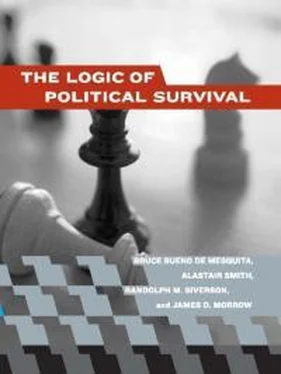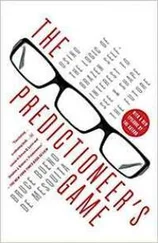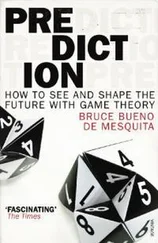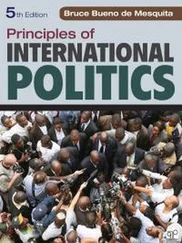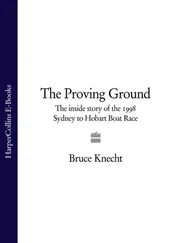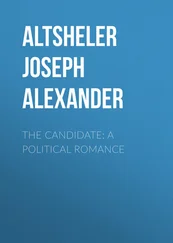Because we focus on selection institutions and political survival, our analysis is concerned to explain how selection institutions shape the incentives and actions of leaders. This focus leads to an important departure in our study from previous efforts to account for the ties between politics and economic choice (e.g., Schumpeter 1942; Moore 1966; Olson 1982, 1993; McGuire and Olson 1996; Wintrobe 1990; Niskanen 1997; Przeworski 2001). Other political-economy accounts of institutional politics tend to assume a different set of values for leaders in democracies and autocracies or investigate a decision-making process that is not strategic and that ignores political competition.
Niskanen (1997), for example, assumes autocracies are led by an individual who wants to maximize the difference between government revenue and spending, with the remainder being available to the leader for personal use. He assumes that the “leader” in a democracy is the median voter and that the median voter is someone with an about-average income who wants to maximize the difference between income and taxes paid. Acemoglu and Robinson (2000) make similar assumptions in distinguishing between systems in which elites choose policy and democratic systems in which average citizens shape policy in the guise of the median voter.
Olson (1993) and McGuire and Olson (1996) present a model that produces results similar to ours with regard to taxing and spending decisions, but they do not include fundamental features of politics, most notably competition over office. Rather than explicitly modeling political competition and the survival of leaders, the McGuire-and-Olson model asks what policies and tax rate maximize the welfare of the leader’s coalition in the absence of a challenger. In contrast, we propose that a leader need not always spend all available resources in order to match the best possible challenge a rival can offer. Additionally, we draw out the strategic dependence between taxing and spending decisions, tenure in office, and preferences over governing institutions. In this way, the selectorate theory extends the political-economy view of institutions proposed by Olson and McGuire and Olson.
Acemoglu and Robinson (2001) explain allocation decisions by leaders in a manner close to the selectorate view of politics. They argue that “the gains to an extractive strategy may depend on the size of the ruling elite. When the elite is small, each member would have a larger share of the revenues, so the elite may have a greater incentive to be extractive” (Acemoglu and Robinson 2001, 1376). This insight guides their empirical study of economic development (2001) and also helps inform their views on tax rates and political stability (2000). They do not, however, develop an equilibrium account in which economic performance, tax rates, institutional stability, and leadership survival are endogenous. Instead, they treat autocrats and democrats as having different, exogenously given utility functions driven, in the first instance, by personal wealth, and in the second, by the median voter’s preferences. In the selectorate theory, we try to endogenize these features of politics while attempting to articulate a theory that can be applied to any form of government, not just autocracy or democracy.
Still others distinguish the utility functions in autocracies and democracies in other ways, but in each case the problem is attacked by assuming a fundamental difference in the interests of leaders in different types of regimes or by overlooking political competition. We suggest that the variation in actions in different political systems can be explained as a result of a common utility function or set of objectives for all leaders, with all political leaders embedded in an institutional environment that includes constraints on coalition size, selectorate size, and rivals for office who cannot credibly commit to give all necessary individuals access to a future stream of private goods in exchange for their current political support. Given these conditions, the selectorate theory indicates that selection institutions—the mechanisms that determine how leaders are chosen or deposed—explain the differences in policy choices across all regime types. Our analysis will show, for example, that it is an equilibrium property of autocracies that leaders achieve a large difference between government revenue and expenditures, as assumed by Niskanen. We also show that it is an equilibrium property of democracies that citizens pay low taxes while the national leader fails to control a large amount of resources, as observed by Lake and Baum (2001) and others.
Challenges to Political Survival
Political survival is put at risk whenever leaders lack the resources to maintain the support of essential backers. Likewise, survival is tenuous when incumbents possess the necessary resources to retain office but misallocate funds. We now briefly consider how these factors impinge on political survival and, therefore, on policy choices.
Financial Crisis = Political Crisis
The survival of leaders and of the institutions or regimes they lead is threatened when they are no longer able to provide sufficient resources to sustain political support. The vast literature on revolutions focuses on moments of crisis—usually economic—when competing elites have incentives to come together to manage their collective survival (Moore 1966; Tilly 1978; Olson 1982; Goldstone 1991; Skocpol 1998). North, Summerhill, and Weingast (2000) point to such moments of crisis as stimulating the emergence of a shared mindset or collective new belief system. In these moments of crisis, as characterized by the Glorious Revolution, as well as by the American, French, Russian, and Chinese Revolutions, new ideas and institutions are accepted by people who earlier were competitors for political authority. These former competitors coordinate with one another to solve a shared problem: the (usually financial or military) crisis of confidence encourages them to cooperate for the moment, putting aside their divergent concerns in the interest of preserving or creating a political setting in which they can in the future return to competing over the distribution of valuable goods. Their incentive to cooperate at a moment of crisis exceeds their divergent interests. Those divergent interests loom larger when resources are sufficient to fight over the distribution of the pie.
Sometimes, in moments of crisis, the emerging consensus of beliefs fosters lasting changes that channel future competition in socially productive directions. This seems to have been the case for the Glorious Revolution and the American Revolution. Other times, the solutions adopted in response to the momentary crisis fail to remove the incentives for destructive forms of competition in the future. In those cases, the divergent interests of competing elites over the future allocation of resources are put on hold during the crisis, then reemerge.
Once a sufficient fix is put in place to restore growth to the total amount of resources, the interests in coordination fall by the wayside and institutions to protect some competitors at the expense of others reemerge. This seems to have been what happened over the decades following the French, Russian, and Chinese Revolutions. This is also a common pattern in the post-World War II years as agencies like the World Bank and International Monetary Fund provide aid during financial crises. By bailing out leaders during such crises, these organizations may unwittingly hinder political reforms that would reduce the odds that the countries in question will experience future economic calamities (Easterly 2001; Bueno de Mesquita and Root 2002). Instead, these international financial institutions may provide the help needed to keep corrupt or incompetent leaders in office. We address these issues and suggest remedies in chapter 10. In examining these issues, we offer a partial explanation for the emergence of “shared mindsets” by demonstrating how selection institutions shape incentives among different parts of a society to come together in an effort to alter the institutions of governance.
Читать дальше
